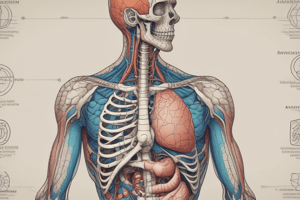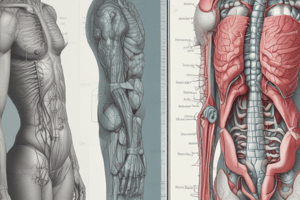Podcast
Questions and Answers
What is the main function of the small intestine?
What is the main function of the small intestine?
- Absorbing nutrients and water from food (correct)
- Storing bilirubin
- Producing and absorbing vitamins
- Forming and propelling feces toward the rectum
Which part of the small intestine is the most mobile?
Which part of the small intestine is the most mobile?
- Ileocecal junction
- Jejunum (correct)
- Duodenum
- Ileum
What is the function of the large intestine?
What is the function of the large intestine?
- Absorbing nutrients and water from food
- Producing and absorbing vitamins, and forming and propelling feces (correct)
- Storing bilirubin
- Regulating blood sugar levels
What is the location of the jejunum in dogs?
What is the location of the jejunum in dogs?
What is unique about the cecum in canines?
What is unique about the cecum in canines?
What is the function of the bacteria in the cecum?
What is the function of the bacteria in the cecum?
What is the length of the cecum in horses?
What is the length of the cecum in horses?
What is the location of the ileum?
What is the location of the ileum?
What is the characteristic of the sigmoidal flexure in ruminants?
What is the characteristic of the sigmoidal flexure in ruminants?
Which of the following is NOT a characteristic of the Ansa distalis coli?
Which of the following is NOT a characteristic of the Ansa distalis coli?
What is the function of the colon transversum in ruminants?
What is the function of the colon transversum in ruminants?
What is the characteristic of the rectum in ruminants?
What is the characteristic of the rectum in ruminants?
What is the characteristic of the lobulation of the liver in ruminants?
What is the characteristic of the lobulation of the liver in ruminants?
What is the characteristic of the gallbladder in horses?
What is the characteristic of the gallbladder in horses?
What is the characteristic of the Facies diaphragmatica of the liver?
What is the characteristic of the Facies diaphragmatica of the liver?
What is the characteristic of the border of the liver?
What is the characteristic of the border of the liver?
What is the shortest part of the colon in a carnivore?
What is the shortest part of the colon in a carnivore?
What is the longest part of the colon in a carnivore?
What is the longest part of the colon in a carnivore?
What is the function of the mesorectum in a carnivore?
What is the function of the mesorectum in a carnivore?
What is the name of the flexure formed by the colon ventral dextrum in an equine?
What is the name of the flexure formed by the colon ventral dextrum in an equine?
What is the order of the parts of the colon in an equine, from right to left?
What is the order of the parts of the colon in an equine, from right to left?
What is the name of the flexure formed by the colon ventral sinistrum in an equine?
What is the name of the flexure formed by the colon ventral sinistrum in an equine?
What is the characteristic of the ansa spiralis in a ruminant?
What is the characteristic of the ansa spiralis in a ruminant?
What is the function of the descending mesocolon in a ruminant?
What is the function of the descending mesocolon in a ruminant?
Study Notes
Small Intestine
- Absorbs nutrients (vitamins, minerals, carbohydrates, fats, proteins) and water from food
Jejunum
- Most mobile part of small intestine
- Located in the ventral part of the abdominal cavity in dogs and covered by greater omentum
- Located in the left dorsal part of the abdomen in horses
- Located in the supramental recess in ruminants
Ileum
- Short terminal part of the small intestine
- Connects to the cecum (first part of the large intestine)
Large Intestine
- Has three primary functions: absorbing water and electrolytes, producing and absorbing vitamins, and forming and propelling feces toward the rectum for elimination
- Divided into the cecum, colon, and rectum in all domestic animals
Cecum
- Unique because it has no direct connection to the ileum in canines
- A short, comma-shaped diverticulum of the ascending colon in cats, about 2-3 cm long
- In horses, it is attached to the dorsal body wall near the right kidney and the root of the mesentery and has sacculation
- In ruminants, it is present between the small intestine and large intestine
- Contains bacteria that digests plant fibers in horses and ruminants
- Has three taeniae with three row sacculations in pigs, similar to horses
Colon
- Divided into the ascending colon, transverse colon, and descending colon
- Has a sigmoidal flexure in ruminants
- Has an Ansa distalis coli (distal loop) that joins to the transverse colon
Rectum
- Located in the pelvic cavity
- Has a transverse fold in ruminants
Liver (Hepat)
- Largest gland in the body, both endocrine and exocrine in function
- Surface: facies diaphragmatica (convex) and facies visceralis (related to stomach, duodenum, transverse colon, jejunum, and right kidney)
- Border: Margo dorsalis (round), Margo ventralis (sharp), Margo sinister (sharp), Margo dexter (sharp)
- Lobulation: right lobe, left lobe, quadrate lobe, and caudate lobe
- Ruminants have single right and left lobes, while carnivores have more lobulation
- Horse has no gallbladder and a quadrate lobe has been cut
- Impressions on the liver are from the colon
Colon Impressions on the Liver
- Colon descendens is the shortest part in carnivores
- Colon transversum passes from right to left between stomach and cranial mesenteric artery
- Colon descendens is the longest part and connects to the rectum
Equine's Colon
- Colon ascendens has four parts: colon ventral dextrum, colon ventral sinistrum, colon dorsale sinistrum, and colon dorsale dextrum
- Colon transversum is the shortest part, involved in the dorsal attachment of the right dorsal colon
- Colon descendens begins to the left of the root of the mesentery and has two taenia bands forming sacculation
Ruminant's Colon
- Colon ascendens has an ansa proximalis coli (proximal loop) and an ansa spiralis (spiral loop) with centripetal and centrifugal turns
- The last centrifugal turn is away from the coil to come close to the jejunum in small ruminants
Studying That Suits You
Use AI to generate personalized quizzes and flashcards to suit your learning preferences.
Description
This quiz covers the anatomy of the jejunum and ileum, including their locations and characteristics in different animals.




